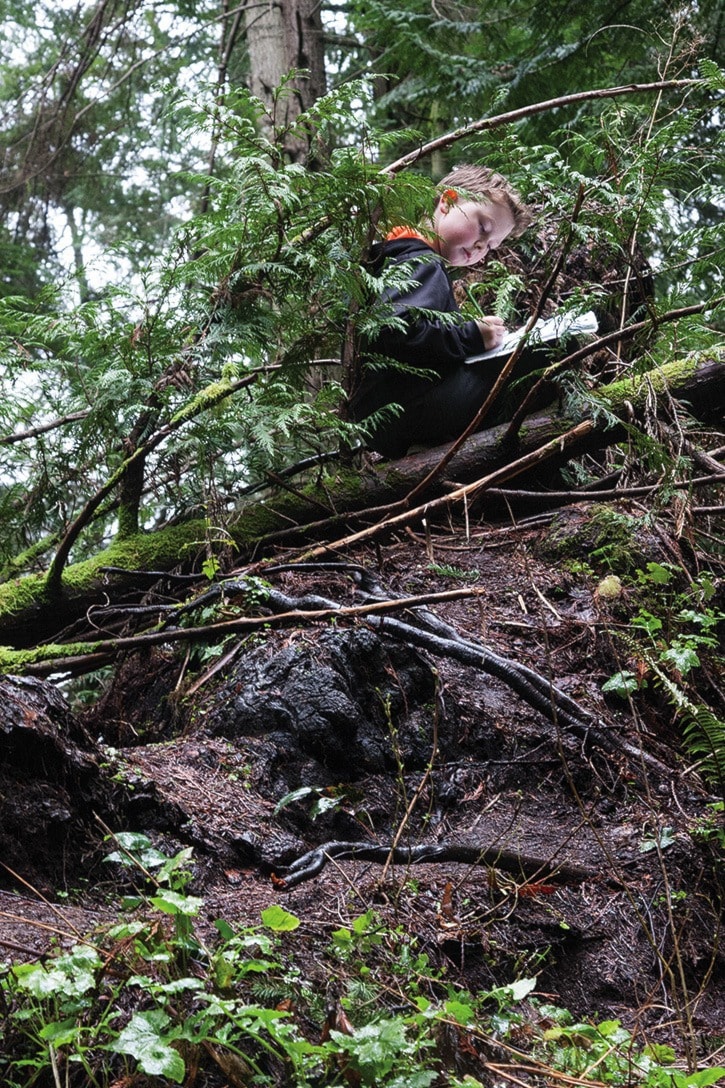Fat rain drops make their way through the forest canopy, but the children don’t seem to notice as they bound down the trail, occasionally stopping to identify different trees, ferns and fungus.
They jump, climb and explore. Rain or shine, they are outside for a portion of almost every school day.
Three short whistle blasts and the children come running, assembling into a straight line and patiently waiting for roll call.
“It’s pretty neat; from the start of the year you can really see how far they’ve come,” said Sangster elementary vice-principal and Grade 4/5 class teacher Jeff Baxter.
“You can tell the days we don’t go out.” Although, he admitted the outdoor time is “as much for the kids as it is for me.”
 After living in Sweden, where nature kindergarten programs are more of a common practice, Baxter returned to Canada with the idea of incorporating more outdoor learning into his teaching style.
After living in Sweden, where nature kindergarten programs are more of a common practice, Baxter returned to Canada with the idea of incorporating more outdoor learning into his teaching style.
He has, like many others, noticed a shift in society towards more screen time for children and wants to help make sure children still get to be outside, like he was growing up.
While occasionally concerns have been expressed about lost learning time, he said time in the forest is still learning time. It is also a chance for those students that may not do as well in a traditional classroom environment to shine in another way.
“As a teacher you have to take a risk,” Baxter said.
He noted that some children can be timid at first, but watching them develop the confidence to climb and jump means they, too, are also learning to take risks. “It was really symbolic to them.”
Roughly halfway through the school year, the children’s outdoor boundaries are larger than when they first ventured into the woods. But after learning more responsibility, they have slowly been allowed to venture further and test themselves more. One rule? If they climb up, they must be able to safely climb down on their own, Baxter said.
“What better way to learn?” he asked.
On this day in the Royal Roads University’s forest that runs behind Sangster, the children are given the choice of two activities once they have arrived at one of their favourite spots to work. Some perch atop a giant tree that has uprooted itself, some examine the exposed root system and others venture into the surrounding brush to see what they can document.
Once the children settle in their tasks, a few short whispers are heard as the odd question is posed, but each student is furiously working in their own way on their own assignment.
“It gives them time to relax and get back in touch with themselves,” said Baxter. “There’s so many positives.”
But Baxter doesn’t want his class to be unique. He wants the concept to become the norm.
Grade 5 student Keira Watson said, “I love it and I hope this idea gets spread around world-wide.”
And it is a concept that is gaining traction. Sangster already has a nature Kindergarten program and Baxter sees his class as an extension of that. Other classes in the school are getting in on the fun and sometimes there’s a bottleneck at the gate to the forest.
“Having the support to be able to do something like this, I feel very lucky … This seemed like a natural fit,” he said.
Naomi El-Nahas, also in Grade 5, said, “After we have a walk in the forest, I always feel ready to learn.”
School District 62 assistant superintendent Roberta Kubik joined the class on one of their outings last week. Once they entered the forest, the students were quick to point out the poisonous daphne plants, and warned her not to touch them. They also pointed out liquorice fern growing high above their heads and several varieties of fungus that they could all name.
“These students are champions of nature and being responsible stewards of nature,” Kubik said. “They’re excited about learning.”
While she noted a lot of teachers in the District regularly take their classes outside, she said Baxter understands how it can tie into all aspects of the classroom. “It really gives them a sense of belonging,” she said.
katie@goldstreamgazette.com
